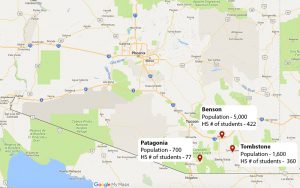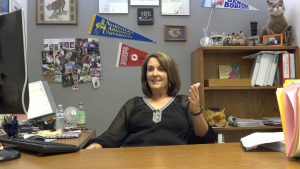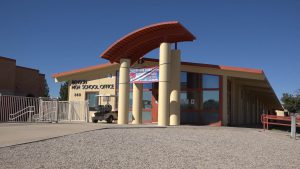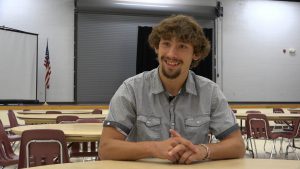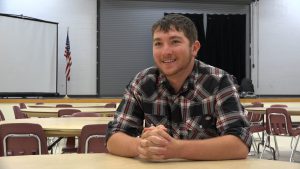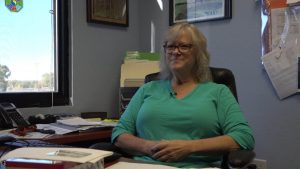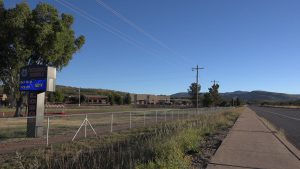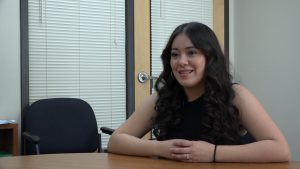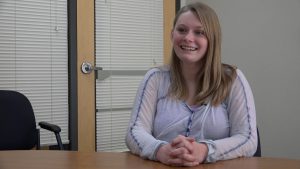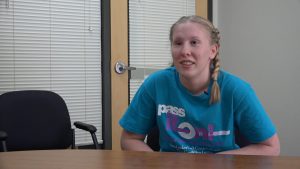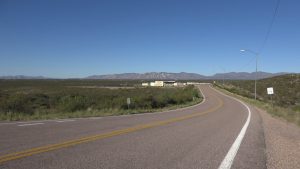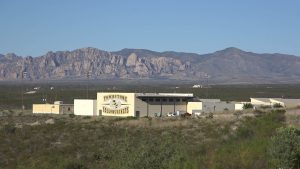- Slug: BC-CNS-Arizona rural schools, 1,600 words
- Photos below
- Map below
By Charity Bidegain
Cronkite News
Cassidy Hancock drives 20 miles each way, Monday through Friday, to attend Tombstone High School, where she is currently a senior. Hancock is taking nursing classes through the school and volunteers at Quiburi Mission Samaritan Center, a nursing home in Benson.
She would love to go to college on a softball scholarship and study to become a forensic anthropologist, but she’s not sure if it is going to happen.
“It’s kind of hard here because nobody really takes the time to look at Tombstone because we are all the way out here,” she said.
Students in rural Arizona counties like Cochise, where Hancock lives, have significantly lower college completion rates than those in counties that have bigger cities and state universities.
Maricopa County (home of Arizona State University), Pima County (home of the University of Arizona), and Coconino County (home of Northern Arizona University) all have bachelor degree completion rates of 30 percent or higher, while the rest of the state ranges from 10 to 24 percent.
To understand the obstacles students like Hancock face and how schools can confront low completion rates, Cronkite News spent time at Tombstone and two other schools: Benson in Cochise County and Patagonia in Santa Cruz County. In Cochise County, 23 percent of residents have obtained a bachelor’s degree. In Santa Cruz County, 22 percent have.
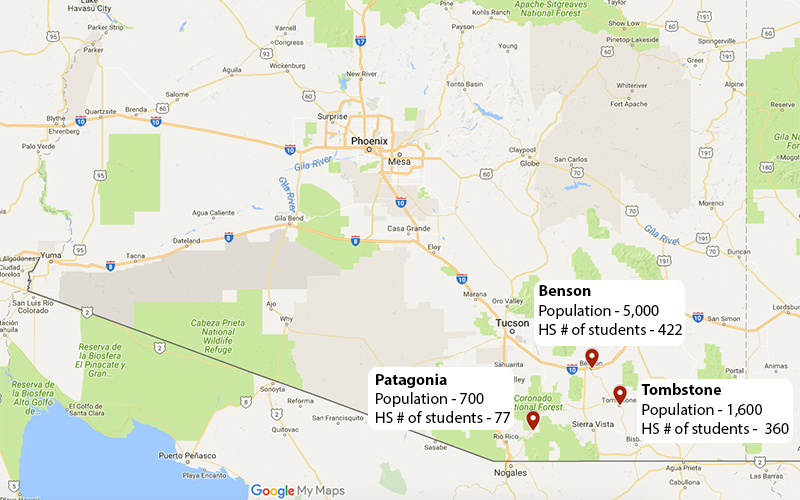
All three are classified as Title I schools, which receive additional federal funding due to a low-income student population. Each town’s median income is well below the statewide average.
Despite those challenges, all three schools have high school graduation rates above 85 percent and attendance rates above 90 percent, and each school is using a variety of approaches to help students find meaningful and sustainable futures.
Tombstone High School: ‘Find something you want to do’
At Tombstone High School, Cassidy Hancock isn’t the only student making the transition to college.
Rebecca Pejak, a senior, said she will receive the Lumberjack full-tuition scholarship to Northern Arizona University, where she wants to complete a bachelor’s degree in biomedical sciences with a minor in political sciences.
“I want to become a physician’s assistant, and I want the minor in political sciences because I’m thinking about running for office, but I want to see if I like it first,” she said.
Pejak said Tombstone prepared her well, but there are limited course offerings at such a small school and she wishes there were more Advanced Placement options.
“There’s a lot of classes that could be honors, but there’s not enough students to take them,” she said.
Viviana Galvez, also a senior at Tombstone, said thinking about life after high school is hard.
“It’s like whether or not you want to stay near your family or whether you want to go and branch out,” she said. “And it’s like the whole thing that you don’t really know what is going to happen after. And it’s scary.”
Not all students will pursue four-year degrees like Hancock, Pejak and Galvez. James Milligan, the career and technical education director and academic counselor at Tombstone, said approximately 38 percent of the graduates will attend Cochise Community College. More than a third of the students are involved in the Army Junior Reserve Officer Training Corps, and many of them plan to go into the military. Tombstone also has many technical programs, including culinary, nursing, business, computer maintenance, law enforcement and agriculture.
Milligan said the school is helping students identify paths that makes sense for their circumstances.
“Obviously, working in the education field, I think that education is important, but I don’t necessarily know if education means college,” he said. “Students need to get involved in something they want to do. To me I think that’s more important. Find something that you want to do, that meets what your skill set is, that meets what you are about as a person, and do that. Whatever it is you want to do, we’ll help you get there.”
Patagonia Union High School: ‘They all have so much potential’
Patagonia High School has just 77 students. It shares a campus with Patagonia Elementary School, and Rosann Clark is the counselor for both.
“Being the one counselor for this many kids, there’s a lot of stuff going on,” Clark said. “And there is a huge difference between high school needs and the elementary, middle school kids’ needs. So just trying to get it all and get up to speed is tricky.”
Clark said the distance from Patagonia to Arizona universities does put the school at a disadvantage. It is sometimes difficult to convince college recruiters to come to the school.
She also said the training for Arizona counselors is in Phoenix, and that makes it hard for her to attend, especially being the only counselor at the school.
“That would be the only bee in my bonnet as long as I’ve lived in Arizona,” she said. “If you’re outside of the ‘state of Maricopa’ they don’t really know you exist.”
Still, Clark said the majority of students have gone on to four-year universities, most often NAU and the U of A. Some of the students will attend Cochise Community College or Pima Community College, and each graduating class has had one or two who go into the military.
“There is always the one or two that, no matter how hard we try, they end up living on mom and dad’s couch for a little while until they figure out what they want to do…and it’s so hard to watch that because they all have so much potential,” she said.
To help students reach that potential, the school uses the Education and Career Action Plans mandated by the state, and Clark said they are still working on utilizing it to its full potential.
Clark said the local community is very supportive, and volunteers come to talk with students whenever asked. There is a strong military influence in the school, which is about a 40-minute drive from Ft. Huachuca. The students can also take the Armed Services Vocational Aptitude Battery, which according to Clark is “one of the best career aptitude tests that’s out there.”
Clark also said that for the past three years the school has done a college application campaign with the Arizona Commission for Postsecondary Education. Community volunteers, as well as college representatives, help students work through college and financial aid applications.
“We always have kids that would like to go out of state, but when they start looking at what it’s going cost them, that’s sort of daunting and they end up staying pretty close,” Clark said.
John Swift, a senior, said he wants to attend an in-state university and study microbiology or biochemistry. If that doesn’t work out, he will enlist in the military.
“Right now I have applied and been accepted to both NAU and U of A. I’m just waiting on scholarship info to see which one gives me the most money so that I can go to school without any student loans, basically,” Swift said.
Christopher Quiroga, also a senior, has been in Patagonia schools since the fourth grade. He wants to join the Air Force and then go through the ROTC program at the U of A for four years and study marine biology or astronomy. He said the teachers at Patagonia have prepared him well.
“The only thing that I’m kind of scared of is the numbers,” he said. “Like going from a class with 17 kids to going to a class with possibly 100 even. So that’s kind of what scares me.”
Benson High School: ‘Let’s start now’
Mindy Sherman, who has been the academic guidance counselor at Benson High School for 16 years, said there are many programs to prepare students for life after graduation.
“It is funny how many parents will come up to me and say, ‘I didn’t go to college. I don’t even know where to start.’ And I say, ‘Well that’s my job. Let’s start now.’”
Benson High School uses the state-mandated action plan program and implements monthly lessons that focus on character development and personality testing. The school hosts college fairs and scholarship information nights and help completing the Free Application for Federal Student Aid.
“As they get older, we are doing resumes, cover letters, letters of recommendation, filling out scholarship applications, filling out job applications, get them on the computer and sign them up for a FAFSA pin number. Just all of those things to get them ready to make choices,” Sherman said.
She emphasized that attending a university right after high school may not be the best choice for everybody.
“It could be a community college, it could be a specialty college, it could be the military, it could be an internship. We have a fantastic partnership with business here and industry in this town, and they will take kids and put them right into an apprenticeship programs,” she said.
According to Sherman, the top 15 percent of the class will receive scholarship offers from universities, but since most scholarships do not cover the full cost of living while attending a university, some will decline.
On average, Sherman said 9 percent of graduates will go straight to a university, 25 to 30 percent will go to a community college and 5 percent will go into the military.
“I tell them…not all of us are going to be doctors and lawyers. And that’s okay,” she said. “We are here no matter what. We kind of have this cheesy little thing: ‘Once a Bobcat, always a Bobcat.’ But it is true. Call. If we can help, we will.”
